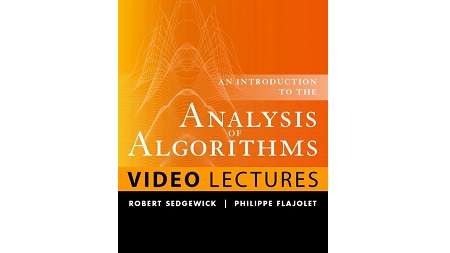
English | MP4 | AVC 1280×720 | AAC 44KHz 2ch | 12h 52m | 6.40 GB
Analysis of Algorithms Video Lectures cover the essential information that every serious programmer needs to know about analyzing algorithms, including analytic combinatorics. In these videos, basic coverage of recurrences, generating functions, and asymptotics leads to an introduction to analytic combinatorics, including labeled and unlabeled combinatorial classes. The videos go on to cover survey trees, permutations, strings and tries, and words and mappings, with applications drawn from the study of widely-used algorithms.
This collection of video lectures provides an introductory exploration of how to mathematically analyze algorithms. Author Robert Sedgewick emphasizes the mathematics required to support scientific studies that can serve as the basis for predicting algorithms and for comparing different algorithms on the basis of performance. Every lecture is accompanied with suggested related readings that you can find in An Introduction to the Analysis of Algorithms, Second Edition. These lectures provide another perspective on the material presented in the book and are in one-to-one correspondence with the chapters in the textbook.
What You Will Learn
- Historical context and motivation for the scientific study of algorithmic performance.
- An introduction to recurrence relations.
- How to use generating functions to solve recurrences.
- How to derive approximate answers via asymptotic analysis.
- How to simplify analysis via analytic combinatorics.
- How to analyze properties of permutations, trees, strings, tries, and mappings.
- Applications to the analysis of classic algorithms from computer science.
Who Should Take This Course
Despite the large amount of literature on the mathematical analysis of algorithms, basic information on methods and models in widespread use has not been directly accessible to students and researchers in the field. This book aims to address that situation. It is intended for:
- Anyone interested in learning more about mathematical methods in the analysis of algorithms.
- Anyone interested in further study in the analysis of algorithms or analytic combinatorics, including study of Knuth’s The Art of Computer Programming.
Lecture 1: Analysis of Algorithms. We begin by considering historical context and motivation for the scientific study of algorithm performance. Then we consider a classic example that illustrates the key ingredients of the process: the analysis of Quicksort. The lecture concludes with a discussion of some resources that you might find useful during this course.
Lecture 2: Recurrences. We begin the course with an overview of recurrence relations, which provide us with a direct mathematical model for the analysis of algorithms. We finish by examining the fascinating oscillatory behavior of the divide-and-conquer recurrence corresponding to the mergesort algorithm and the general “master theorem” for related recurrences.
Lecture 3: Generating Functions. Since the 17th century, scientists have been using generating functions to solve recurrences, so we continue with an overview of generating functions, emphasizing their utility in solving problems like counting the number of binary trees with N nodes.
Lecture 4: Asymptotics. Exact answers are often cumbersome, so we next consider a scientific approach to developing approximate answers that, again, mathematicians and scientists have used for centuries.
Lecture 5: Analytic Combinatorics. With a basic knowledge of recurrences, generating functions, and asymptotics, you are ready to learn and appreciate the basic features of analytic combinatorics, a systematic approach that avoids much of the detail of the classical methods that we have been considering. We introduce unlabelled and labelled combinatorial classes and motivate our basic approach to studying them, with numerous examples.
Lecture 6: Trees. The quintessential recursive structure, trees of various sorts are ubiquitous in scientific enquiry, and they arise explicitly in countless computing applications. You can find broad coverage in the textbook, but the lecture focuses on the use of analytic combinatorics to enumerate various types of trees and study parameters.
Lecture 7: Permutations. The study of sorting algorithms is the study of properties of permutations. We introduce analytic-combinatoric approaches to studying permutations in the context of this relationship.
Lecture 8: Strings and Tries. From DNA sequences to web indices, strings (sequences of characters) are ubiquitous in modern computing applications, so we use analytic combinatorics to study their basic properties and then introduce the trie, an essential and fundamental structure not found in classical combinatorics.
Lecture 9: Words and Mappings. We view strings as sets of characters or as functions from [1..N] to [1..M] to study classical occupancy problems and their application to fundamental hashing algorithms. Functions from [1..N] to [1..N] are mappings, which have an interesting and intricate structure that we can study with analytic combinatorics.
Table of Contents
01 Brief History
02 Analysis of Algorithms
03 Context
04 Analytic Combinatorics
05 History and Motivation
06 A Scientific Approach
07 Example – Quicksort
08 Resources
09 Computing Values
10 Telescoping
11 Types of Recurrences
12 Mergesort
13 Master Theorem
14 Ordinary Generating Functions
15 Solving Recurrences
16 Catalan Numbers
17 Exponential Generating Functions
18 Counting with Generating Functions
19 Standard Scale
20 Manipulating Expansions
21 Asymptotics of Finite Sums
22 Bivariate Asymptotics
23 The Symbolic Method
24 Labelled Objects
25 Coefficient Asymptotics
26 Perspective
27 Trees and Forests
28 Binary Search Trees
29 Path Length
30 Other Types of Trees
31 Basics
32 Sets of Cycles
33 Left-Right-Minima
34 Other Parameters
35 BGFs and Distributions
36 Bitstrings with Restrictions
37 Languages
38 Tries
39 Trie Parameters
40 Words
41 Birthday Problem
42 Coupon Collector Problem
43 Hash Tables
44 Mappings
Resolve the captcha to access the links!